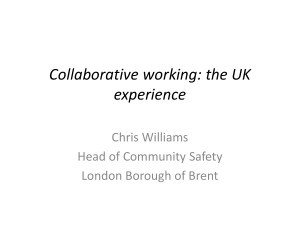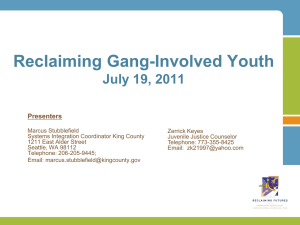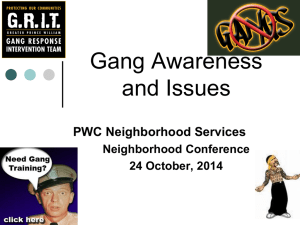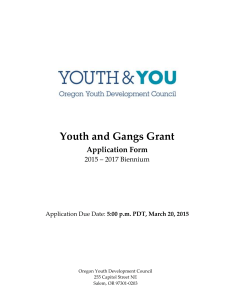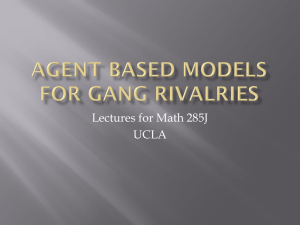Chapter 11 Powerpoint (2) Gangs
advertisement
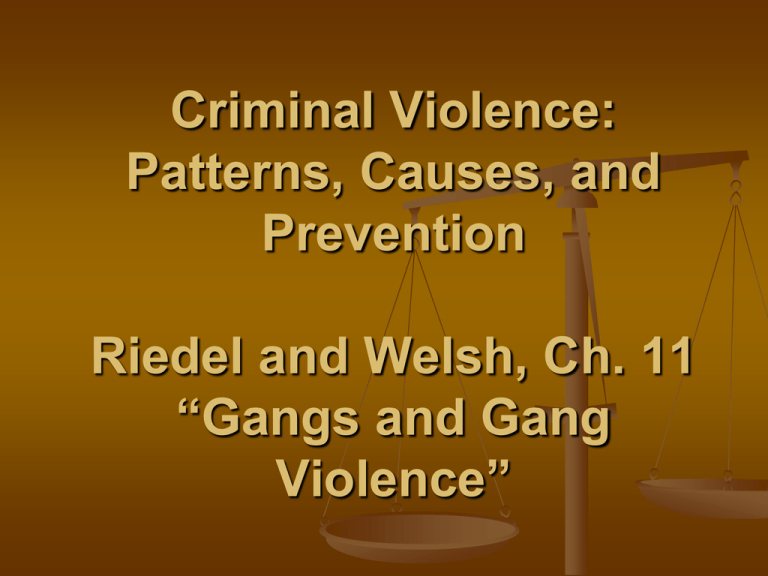
Criminal Violence: Patterns, Causes, and Prevention Riedel and Welsh, Ch. 11 “Gangs and Gang Violence” A Problem of Definition No consensus on the meaning of the term Definition provides indication of the number of gangs Gang member vs. gang motive Definition provides information for resource allocation and public fear of crime Cities may deny there is a gang problem for political and social reasons. Awareness of gang problems hurts tourism. Focusing the Definition “A street gang is any durable, streetoriented youth group whose involvement in illegal activity is part of its group identity” (Klein & Maxson, 2006, p. 4) Definition has been agreed upon by more than 100 American and European researchers. Minimal definition is sufficient for distinguishing street gangs from other youth groups. Are You a Gang Member? Self-nomination One method of determining who is a gang member is to ask adolescents. Research done indicates that as definitions involved more gang characteristics, respondents became more antisocial. Self-nomination has been shown to be a useful technique. Are You a Gang Member? (cont.) Law enforcement uses crimes committed as an important criterion. Also uses self-nomination technique to designate individuals Rural counties rely on display of tattoos, colors, or other symbols. Self-nomination and crimes committed are two most important measures. Growth and Change in Gangs Figure 11.1 Percent Change in the Estimated Number of Gangs, 2002-2007 70 64.4 60 50 Percent 40.9 40 30 20 25.5 15.3 17 10 0 Larger Cities Suburban Cnts. Smaller Cities Area Rural Cnts. Total Size of the Problem Number of gangs increased to 27,300 by 2007. Decreased to 20,100 by 1995, then increased Figure 11.1 shows greatest change from 2002 to 2007 has been in rural counties. Compared to total number of gangs, rural counties have the smallest number while larger cities have the largest number. Demographics Age: Percent of gang members over 18 has consistently increased, to 63.5% in 2006. Gender: Over 90% of gang members are males. Race/Ethnicity: Hispanic or Latino gang most frequent, followed by AfricanAmerican gangs White gangs are the fewest in number. Gang Organization and Violence Five types of gangs : Traditional, Neotraditional, Compressed, Collective, and Specialty Specialty gang is narrowly focused on specific set of criminal acts such as burglary or drugs. Gang Violence: Most frequent crimes are drug sales, aggravated assaults, and robberies. Gang-related homicides are 5% to 7%. Explanations Strain Theories: Based on Merton’s theory Cohen: Lower-class rejection of middle-class values Cohen’s delinquent acts were “malicious, nonutilitarian and negativistic” Cloward and Ohlin: Saw a conflict between lower- and middle-class values and limited structural opportunities Posited illegitimate opportunity structures Explanations (cont.) Cultural deviance theories emphasize conflicts in cultural beliefs Walter Miller’s theory emphasized focal concerns: cultural values that coincidentally conflicted with middle-class beliefs Marvin Wolfgang and Franco Ferracuti postulated a subculture of violence theory: Lower-class youth use violence as a method of solving interpersonal problems Explanations (cont.) Social control theories try to explain why people do not commit crimes and violence. Travis Hirschi focused on the social bond: What are the social forces and institutions that “keep people in line”? James Vigil and Steve Yun applied social control and multiple marginality to Mexican gangs. Interventions Five Types of Intervention Suppression includes arrest, incarceration, and other forms of criminal justice. Social Intervention includes social and psychological approaches, street workers, and religious conversions. Organizational Change and Development Community Organization Opportunities Provision refers to job training, increasing opportunities for employment, and assistance with school. Operation Ceasefire Boston Police Department started program to reduce gang violence. Focused on small number of serially offending, gang-involved youth Emphasis was on gun trafficking within the state. “Lever pulling” meant that any violent event would set off a coordinated response by police and social services. Evaluations were positive and programs in other cities were started.

